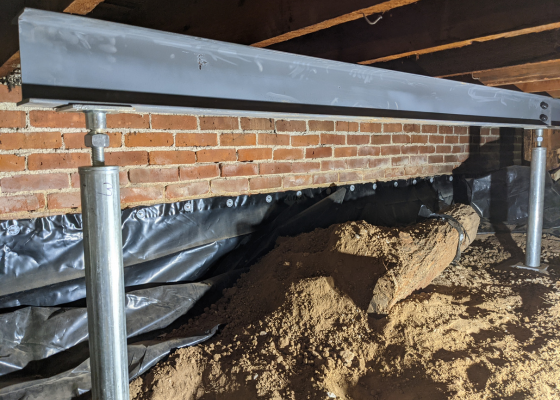
Maintaining the Health of Your Floor Joists
Floor joist issues are more common than you might realize. Proper maintenance is crucial to ensure your home’s structural integrity. Here’s what you need to know about floor joist problems and how to address them.
Floor Joist Repair Solutions
Floor joists play a vital role in supporting your home’s structure and foundation. Any issues with floor joists can lead to significant problems down the line. Understanding these issues and knowing how to prevent them is essential for maintaining a healthy home.
Causes of Floor Joist Failure
- Insufficient Support: A common cause of floor joist failure is inadequate support. This often happens when heavy additions are made to areas without enough underlying support, such as installing heavy marble countertops without reinforcing the floor joists.
- Mold, Mildew, and Wood Rot: Fungal growths like mold and mildew thrive in high humidity, deteriorating the organic material in wood joists. Moisture control in crawl spaces can prevent these fungi from weakening your joists.
- Waterlogged Wood: Standing water in the crawl space can lead to waterlogged wood, significantly reducing its strength. Addressing standing water promptly can prevent this issue and the subsequent damage it causes.
Warning Signs of Floor Joist Failure
- Sinking Floors: If the edges of your floors are not aligned or are sinking, it indicates potential issues with the floor joists or the foundation.
- Uneven Floors: Uneven floors suggest that one side of the joists is sinking more than the other, often due to a failing floor joist.
- Bouncy Floors: Floors that sag under weight might indicate wood rot, making the wood more flexible and less supportive.
- High Indoor Humidity: Excess moisture in the crawl space can lead to high indoor humidity, promoting mold growth and wood deterioration.
- Flooding in the Crawl Space: Flooding causes standing water and high humidity, leading to various types of floor joist failure.
- Unencapsulated Crawl Space: An unencapsulated crawl space allows moisture to rise, making it difficult to maintain a dry environment and leading to floor joist issues.
Preventing and Addressing Floor Joist Issues
Effective solutions to floor joist problems involve addressing the root causes and implementing preventive measures. Key steps include:
- Encapsulation: Encapsulating the crawl space can prevent moisture from entering, reducing the risk of mold, mildew, and wood rot.
- Moisture Control: Installing a sump pump and dehumidifier can help manage moisture levels in the crawl space.
- Structural Reinforcement: Reinforcing or replacing weakened joists ensures your home’s structural integrity.
For expert floor joist repair and preventive measures, contact Springs Foundation Repair. Schedule a free inspection today to ensure your home remains safe and structurally sound. Schedule your free inspection to protect your home from floor joist issues and maintain its structural health.
Sagging Floors
How to Address and Fix Sagging Floors in Your Home
Sagging floors are a significant problem that often points to deeper structural issues. Here’s how you can identify them early:
- Secondary Signs: Look for high indoor humidity, musty smells in the crawl space, waterproofing concerns, and general crawl space issues. These signs can indicate underlying problems that may lead to sagging floors.
- Professional Inspections: Expert inspections are the best way to detect sagging floors early. Professionals have the tools and knowledge to identify slight declines that are not visible to the naked eye.
- DIY Inspections: Regular self-inspections can help you notice changes over time. While not as thorough as professional inspections, they allow for more frequent monitoring.
Impact of Sagging Floors
Sagging floors can affect various parts of your home:
- Crawl Space: Issues with floor joists, often due to moisture or structural problems, can cause floors to sag. This can lead to additional problems like standing water in the crawl space, which can further damage the joists and other structural elements.
- Home Structure: Sagging floors can cause foundation issues. As floors sag, the edges pull inward, potentially shifting the foundation. This can lead to significant structural damage if not addressed promptly.
- Property: While less common, sagging floors can indicate broader issues with the property, such as hydrostatic pressure affecting foundation walls. This can suggest problems with the soil around your home.
Solutions for Sagging Floors
Addressing sagging floors involves a combination of repairs and preventative measures:
- Crawl Space Encapsulation: Encapsulating the crawl space can prevent moisture from entering and damaging the floor joists.
- Installing Supports: Adding additional supports or reinforcing existing ones can help stabilize sagging floors.
- Moisture Control: Implementing solutions like sump pumps, dehumidifiers, and proper drainage systems can prevent moisture-related damage.
- Professional Repairs: Engage experts to perform thorough repairs and ensure the structural integrity of your home. They can provide tailored solutions based on the specific issues affecting your floor joists and crawl space.
For expert assistance in diagnosing and repairing sagging floors, contact Springs Foundation Repair. Schedule a free inspection to ensure your home’s structural health and stability. Schedule your free inspection today to address and prevent sagging floors and protect your home from further damage.
